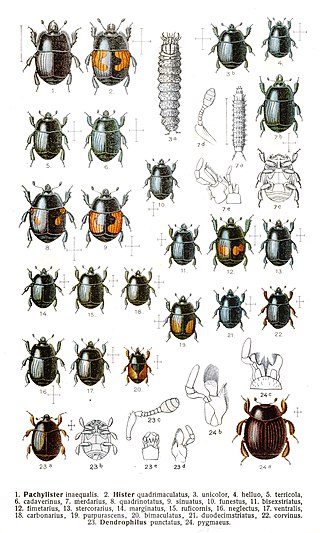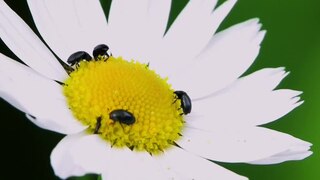
Histeridae is a family of beetles commonly known as clown beetles or hister beetles. This very diverse group of beetles contains 3,900 species found worldwide. They can be easily identified by their shortened elytra that leaves two of the seven tergites exposed, and their geniculate (elbowed) antennae with clubbed ends. These predatory feeders are most active at night and will fake death if they feel threatened. This family of beetles will occupy almost any kind of niche throughout the world. Hister beetles have proved useful during forensic investigations to help in time of death estimation. Also, certain species are used in the control of livestock pests that infest dung and to control houseflies. Because they are predacious and will even eat other hister beetles, they must be isolated when collected.

Trogidae, sometimes called hide beetles, is a family of beetles with a distinctive warty or bumpy appearance. Found worldwide, the family includes about 300 species contained in four or five genera.

Dermestidae are a family of Coleoptera that are commonly referred to as skin beetles. Other common names include larder beetle, hide or leather beetles, carpet beetles, and khapra beetles. There are over 1,800 species described.

Cleridae are a family of beetles of the superfamily Cleroidea. They are commonly known as checkered beetles. The family Cleridae has a worldwide distribution, and a variety of habitats and feeding preferences.

Cryptophagidae is a family of beetles with representatives found in all biogeographic realms. Members of this family are commonly called silken fungus beetles and both adults and larvae appear to feed exclusively on fungi although in a wide variety of habitats and situations, such as rotting wood and shed animal fur and feathers. These beetles vary from about 1 to 11 millimeters long, and usually have an oval body shape with a slight "waist".

Parasitellus is a genus of mites in the family Parasitidae which are obligatory parasites of bumblebees. These mites can be found clinging to the carapace, sometimes in large numbers. Mites in this genus hibernate in the deutonymphal stage. In the tritonymph stage they can actively transfer from bumblebee to bumblebee from flowers, where they can survive up to 24 hours. After they arrive in a bumblebee nest, they will moult into adults. Whilst it is not known what factors trigger the mite to molt, in laboratory conditions P. fucorum were found to moult after eating fresh pollen, although overall moulting success was low. They are kleptoparasitic or neutral to beneficial, depending on life stage; females and deutonymphs feed on provisioned pollen, while other stages are predators of small arthropods.

Phoresis or phoresy is a non-permanent, commensalistic interaction in which one organism attaches itself to another solely for the purpose of travel. Phoresis has been observed directly in ticks and mites since the 18th century, and indirectly in fossils 320 million years old. It is not restricted to arthropods or animals; plants with seeds that disperse by attaching themselves to animals are also considered to be phoretic.
Trichobaris trinotata, commonly known as the "Potato stalk borer", is a species of weevil in the family Curculionidae. It is found in North America where it is a pest of potato plants, the larvae tunnelling inside their stems.
Scaphinotus andrewsii is one of 60 species of ground beetles in the family Carabidae. It is found in North America, living in moist areas and eat snails.

Epuraea is a genus of sap-feeding beetles in the family Nitidulidae, first described in 1843 by Wilhelm Ferdinand Erichson. There are at least 40 described species in Epuraea. Their most notable food source is sap but these beetles also feed on organic matter such as fruits, flowers, fungi, decaying plant tissue, and the tissue of dead animals. Some species occur in bumblebee nests. Epuraea beetles commonly overwinter underneath logs or in soil.
Amara neoscotica is a species of seed-eating ground beetle in the family Carabidae. It is found in North America.

Brassicogethes aeneus, the common pollen beetle, is a species of pollen beetle in the family Nitidulidae. Other common names include the rape pollen beetle and rape blossom beetle. It was previously known as Meligethes aeneus.

Antherophagus is a genus of silken fungus beetles in the family Cryptophagidae. There are at least four described species in Antherophagus.

Cryptophagini is a tribe of silken fungus beetles in the family Cryptophagidae. There are about 8 genera and at least 60 described species in Cryptophagini.

Eupsilobiidae is a family of beetles in the superfamily Coccinelloidea, formerly included within the family Endomychidae. Most genera are restricted to the Neotropics, while the genus Eidoreus is found worldwide. They are fungivores, and have been observed living commensally in bee and ant nests.

Limnichidae, commonly called minute marsh-loving beetles, is a family of beetles belonging to Byrrhoidea. There are at least 30 genera and 350 described species in Limnichidae. They are found worldwide, with the greatest diversity in tropical regions. Most species seem to be associated with water-adjacent habitats, such as riparian and coastal locations, though many species are likely fully terrestrial, with some species being associated with leaf litter and arboreal habitats. Species with known diets feed on moss or algae. The oldest fossils of the family are known from mid-Cretaceous Burmese amber from Myanmar.

Rhipiceridae is a family of beetles found worldwide. The larva of rhipicerids are parasitoids of cicada nymphs. Rhipiceridae and Dascillidae form the super family Dascilloidea, within the Elateriformia.

Throscidae is a family of elateroid beetles found worldwide with around 150 species in 5 extant genera. The larvae are soil-dwelling, siphoning fluid from mycorrhizae attached to trees. The adults are short-lived, with the adult males being noted for a complex mating dance. Like some other elateroids, they are capable of clicking.

Cryptophaginae is a subfamily of silken fungus beetles in the family Cryptophagidae. There are about 11 genera and more than 180 described species in Cryptophaginae.

Atomariini is a tribe of silken fungus beetles in the family Cryptophagidae. There are about 5 genera and at least 70 described species in Atomariini.

















